Slow Cooker Energy Usage
How much battery power does it take to make Pork and Sauerkraut in a Slow Cooker?
Dear Mike,
We’re planning on boondocking this summer because finding a campground with available spots is a nightmare. I love the idea of boondocking without using a generator, but I wonder if this would be practical for my wife’s cooking style?
She loves her slow cooker (not an Instant Pot), and so we would like to know just how much battery power one would need to do this. Can I power it from one of those portable battery boxes? How about adding more solar panels to my RV? Hey, I’m serious about good food while boondocking. Any ideas on how to make this work? —Sam and Edna
Dear Sam and Edna,
You’re in luck because I just finished a quick study of how much power my wife’s Hamilton Beach slow cooker used to make pork and sauerkraut. This is part of my year-long study on how much electric energy you need for an all-electric kitchen in an RV.
Now, I’m just as serious about food as you two obviously are, so in the interest of science I plugged in a Kill A Watt meter before she got started on the 8-hour slow-cooking process of her Pork and Sauerkraut. BTW – It’s delicious…
How much power does a slow cooker use?
These are electrically very simple devices – basically, just a heating element with two or three wattage levels. There’s no thermostat that I can find, except for an over-temp fuse that will shut off the power if it gets way too hot.
This is an old-school slow cooker without a thermostat or timer. You just plug it in and occasionally turn the heater up to high or down to low. It’s that simple.
Low-power mode
So when you put it on the Low setting, I found that it draws around 123 watts of power during operation.
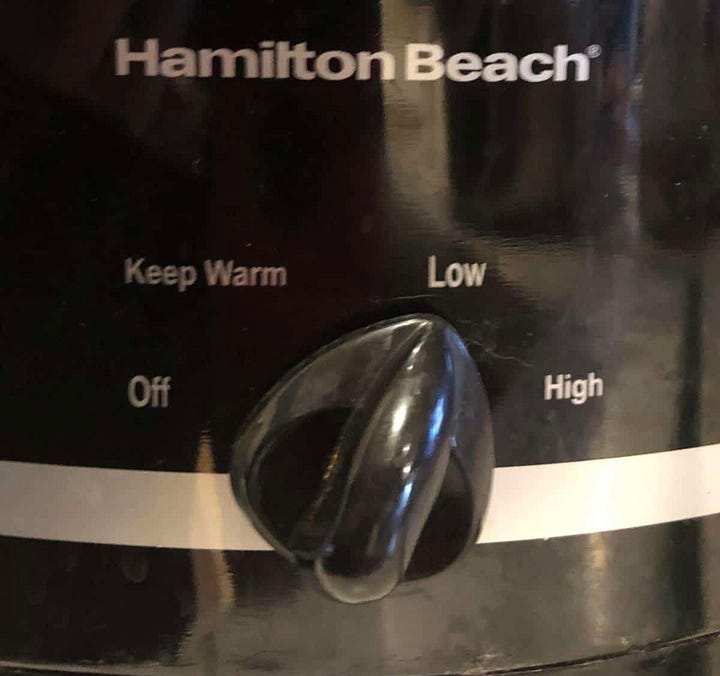

High Power Mode
And when you put it on the High setting, I found that it draws around 189 watts of power.
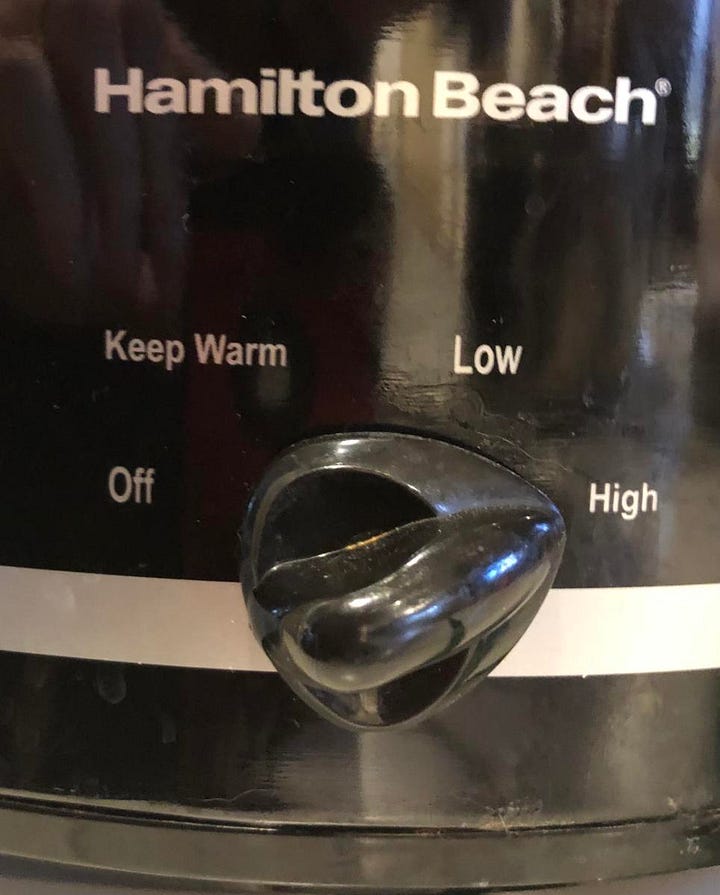
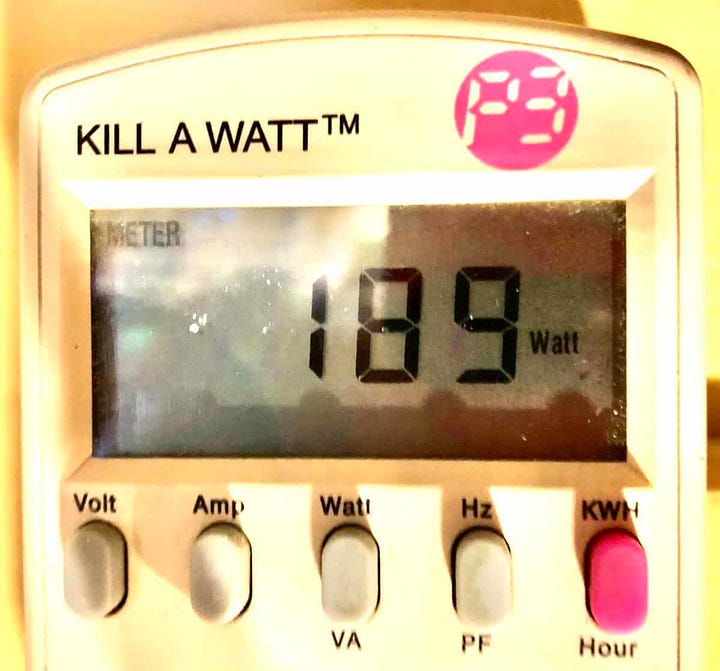
Total energy!
But the real question is: How much energy will it use over 8 hours of slow cooking? For some reason I couldn’t convince my wife to fill out a time sheet of when she switched between High and Low power. She said something about having too many other things to worry about when cooking a meal to fill in a time sheet.
But I did get the cumulative energy usage after 8 hours of slow cooking, which was 1.17kWh, or 1170 watt-hrs. That’s equivalent to powering a 60-watt tungsten light bulb for around 19 hours.
If you were plugged into an outlet at your house, that’s not a lot of energy. Consider that if you’re paying 15 cents per kWh to the power company, then that only amounts to around 17.5 cents for those 8 hours of slow cooking. Pretty good deal…
But what about a Jackery 1500 and 400 watts of solar panels?
Well, I have two examples of battery power to consider. If you compare this to the amount of energy available in a Jackery 1500, you’ll note that 1,170 watt-hrs / 1,500 watt-hrs = 78%. So this will use around 3/4 of the available stored energy in your Jackery 1500.
However, if you have the 400 watts of solar panels sitting in the sun while doing this, it would be nearly a break-even energy usage situation. That is, the solar panels should be able to recover those lost 1,170 watts as long as the sun is shining, plus have a few hundred watt-hrs of extra energy stored in the battery.
What about a RV with a 400 amp-hr battery and 600 watts of solar panels?
In this case, we have a lot of stored energy in the 400 amp-hr MasterVolt Lithium Battery, plus three 200-watt solar panels in my GeoPro RV. To find watt-hrs from the 400 amp-hrs at 12 volts we just multiply amp-hrs times volts and find that it equals 4,800 watt-hrs of energy.
Even without any solar panels we can calculate that the 1,170 watt-hrs of energy needed by the slow cooker is 1,170 / 4,800 = 23% of available battery storage. So, you would need less than one quarter of your available battery power for this slow cooker heating cycle. And the 580 watts of solar panels on the roof of the Geo Pro would easily recover that energy in just a few hours of sunshine. So, your wife could be making Pork and Sauerkraut every day on solar power alone. Of course, you can make chili or pot roast or pulled pork, or anything else you like!
Yes, these are just SWAGs
I know I haven’t considered inverter overhead or battery charge/discharge efficiencies, so the actual numbers I’m showing could vary by plus or minus 10%. So, I have to gather some more empirical data to fine-tune my usage model. But don’t worry, I’ll get there.
We can probably all see that the day of the all-electric RV kitchen is fast approaching. I’m now a firm believer in the 12-volt DC compressor refrigerator, and who can argue with the convenience of a microwave oven. But there’s a lot of new appliances, such as the induction cooktop, that are good candidates for replacing the propane cooktop. Good thing I have a high enough metabolism to try out all the great test food! So let the RV kitchen testing begin.
Stand by for taste tests on solar/battery power
In the interest of science, I already have some all-electric cooking and baking experiments lined up this spring and summer. My wife is a fantastic cook with years of experience as a catering manager. And my son Kevin is a Culinary Institute graduate who teaches baking and pastry making in a tech school. I’m pretty decent on the grill, and Santa did bring me a pellet smoker for Christmas. So, we’ve all volunteered to help measure energy usage with electric cooking appliances such as induction cooktops, air fryers, sous vide cookers, and pellet smokers. Yummy!
Let’s play safe out there… Mike

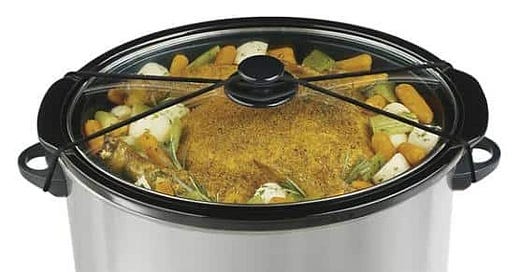



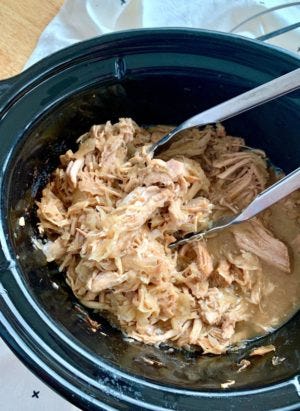
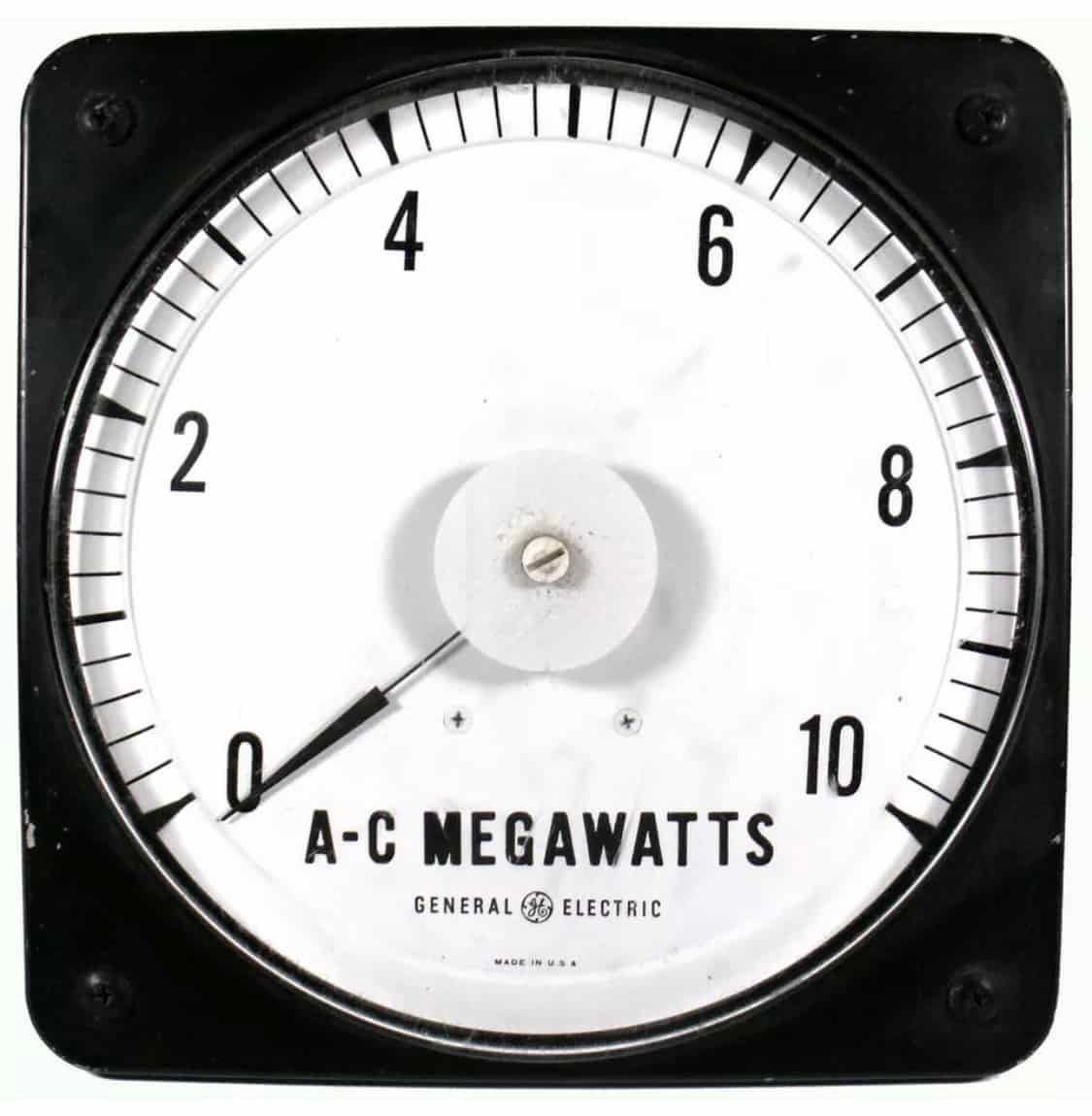

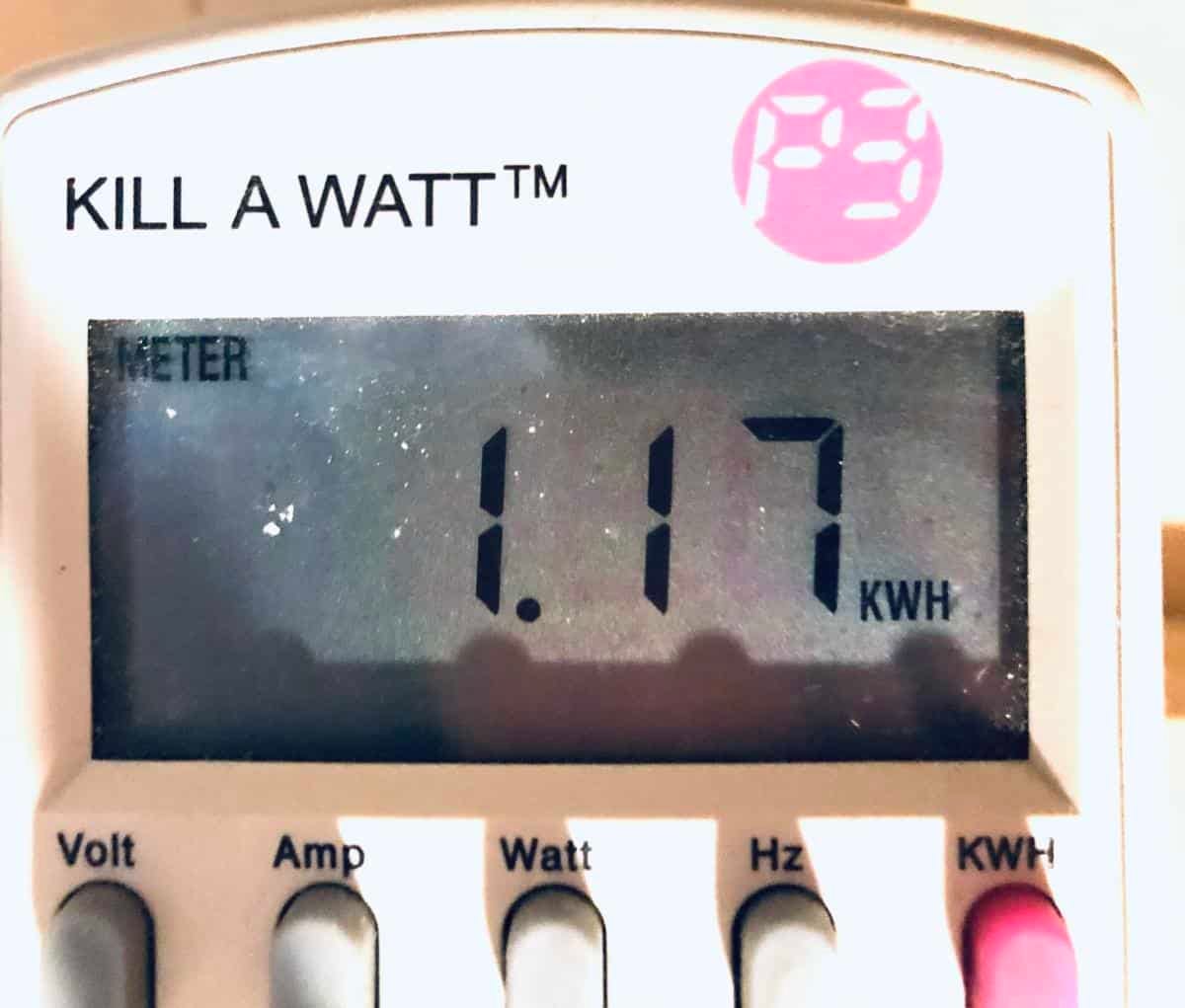
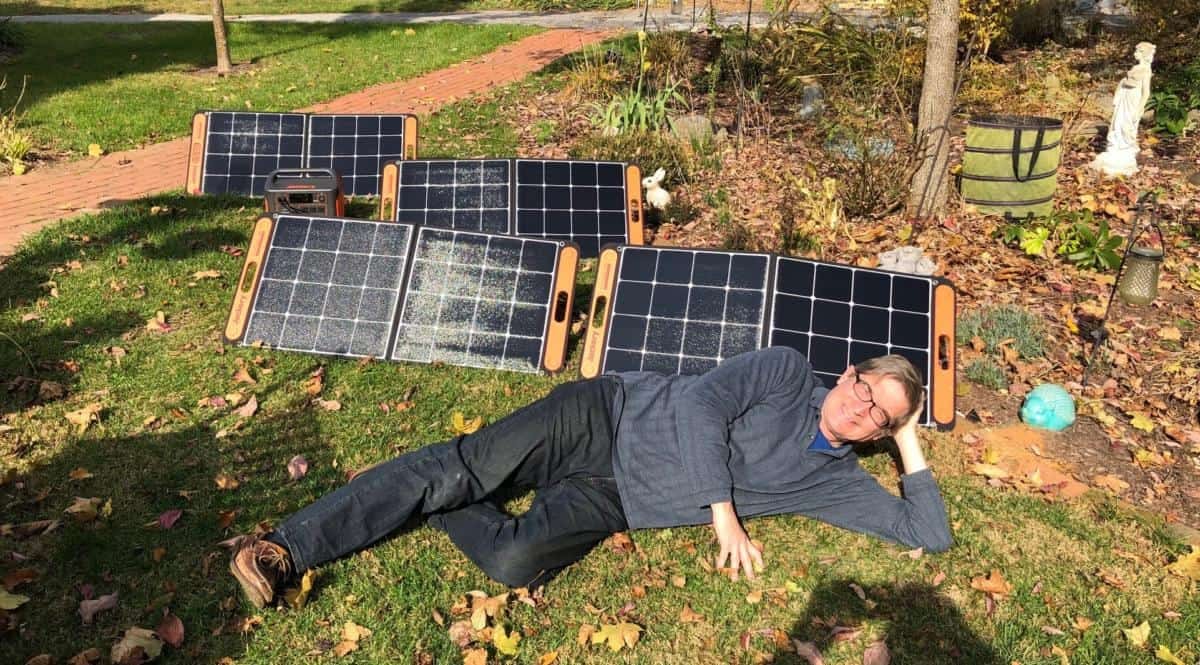
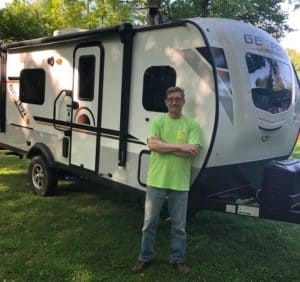


Great article!
I have a slow cooker story as well. A few years ago we were camping up in PA and were planning to go for a hike. My wife wanted to make pulled pork, but if she didn't start it until we got back it would not be done until late. At the time, we only had 200W worth of panels on the roof and 2 'tall' 260Ah golf cart batteries. From using the Kill-a-Watt meter, I knew the cooker uses ~200W on high, but it cycles on/off.
It was around noon and a clear day, so the panels were putting out close to their max -- not the 'Yuma, Az at high noon in July' claimed max of 200W, but maybe 150W. So we put the pork in, turned it on, and went for our walk. When we returned, the RV smelled wonderful! The pork was almost done, and the batteries were still at 100% SOC.
BTW Mike, if you and your wife and son need any objective taste testers, we're only about 20 minutes away. ;-)
Mike thanks for all the great information! I wonder if there may be a side by side comparison for using electricity compared to propane. That would be very interesting to see those energy numbers! For some reason my wife isn't interested in making pork & sauerkraut, I like it on my hot dogs but thats as far as it goes in our house.
Thanks
Snoopy